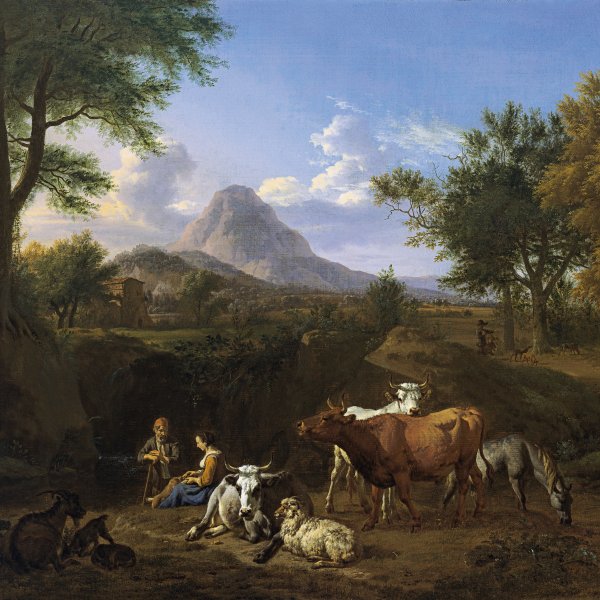Adriaen van de Velde
Amsterdam, 1636-1672
Adriaen van de Velde was born in to a family of painters. Both his father, Willem van de Velde I, and his brother, Willem van de Velde the Younger, were celebrated marine artists. Like his brother, Adriaen van de Velde first trained with his father. He then moved to Haarlem to complete his apprenticeship in the studio of Jan Wijnants, a painter who specialised in dune landscapes. In 1657 he settled in Amsterdam, where he lived until his death. Although his career only lasted around two decades, Van de Velde was a highly prolific artist who produced a large number of paintings, drawings and prints, and signed works survive from almost every year between 1654 and 1671. Most of his oeuvre comprises landscapes of Holland, as well as Italian views, particularly after 1667. The latter are based on the works of Nicolaes Berchem and Karel du Jardin and there is no information to suggest that Van de Velde travelled to Italy. They depict shepherds and animals in mountainous landscapes, often with classical ruins and illuminated by a clear, Mediterranean light. Van de Velde was a versatile artist who also painted winter scenes, portraits set in exteriors, allegories, and religious and historical compositions, as well as a few genre paintings.
The figures in his compositions are notable for their large scale, their individuality and the care with which they are painted. As a result they can be considered more than anecdotal elements within the landscape. Van de Velde was often commissioned to paint figures in compositions by fellow artists and his hand can be detected in works by Jacob van Ruisdael, Hobbema, Frederik de Moucheron, Philips Koninck, Jan van der Heyden and Jan Wijnants. Van de Velde died in Amsterdam in 1672 at the early age of thirty-five, the same year that his father and brother left Holland to settle in England.
The figures in his compositions are notable for their large scale, their individuality and the care with which they are painted. As a result they can be considered more than anecdotal elements within the landscape. Van de Velde was often commissioned to paint figures in compositions by fellow artists and his hand can be detected in works by Jacob van Ruisdael, Hobbema, Frederik de Moucheron, Philips Koninck, Jan van der Heyden and Jan Wijnants. Van de Velde died in Amsterdam in 1672 at the early age of thirty-five, the same year that his father and brother left Holland to settle in England.





